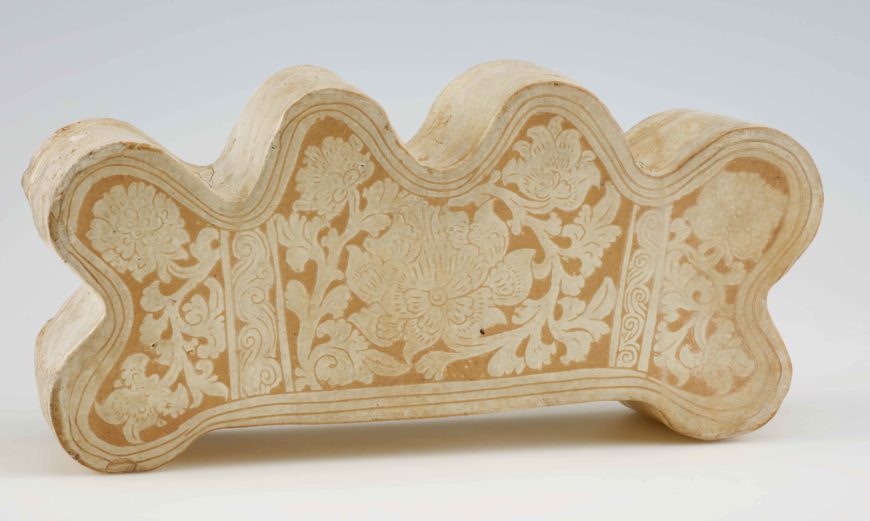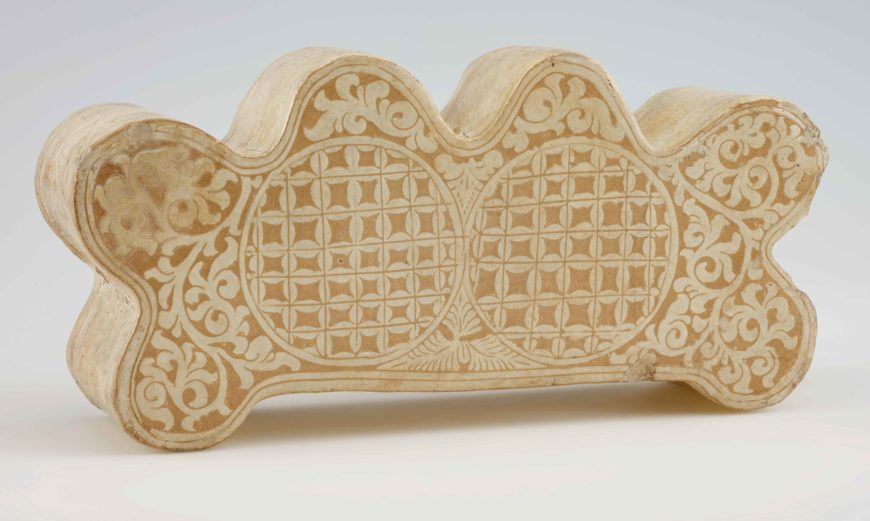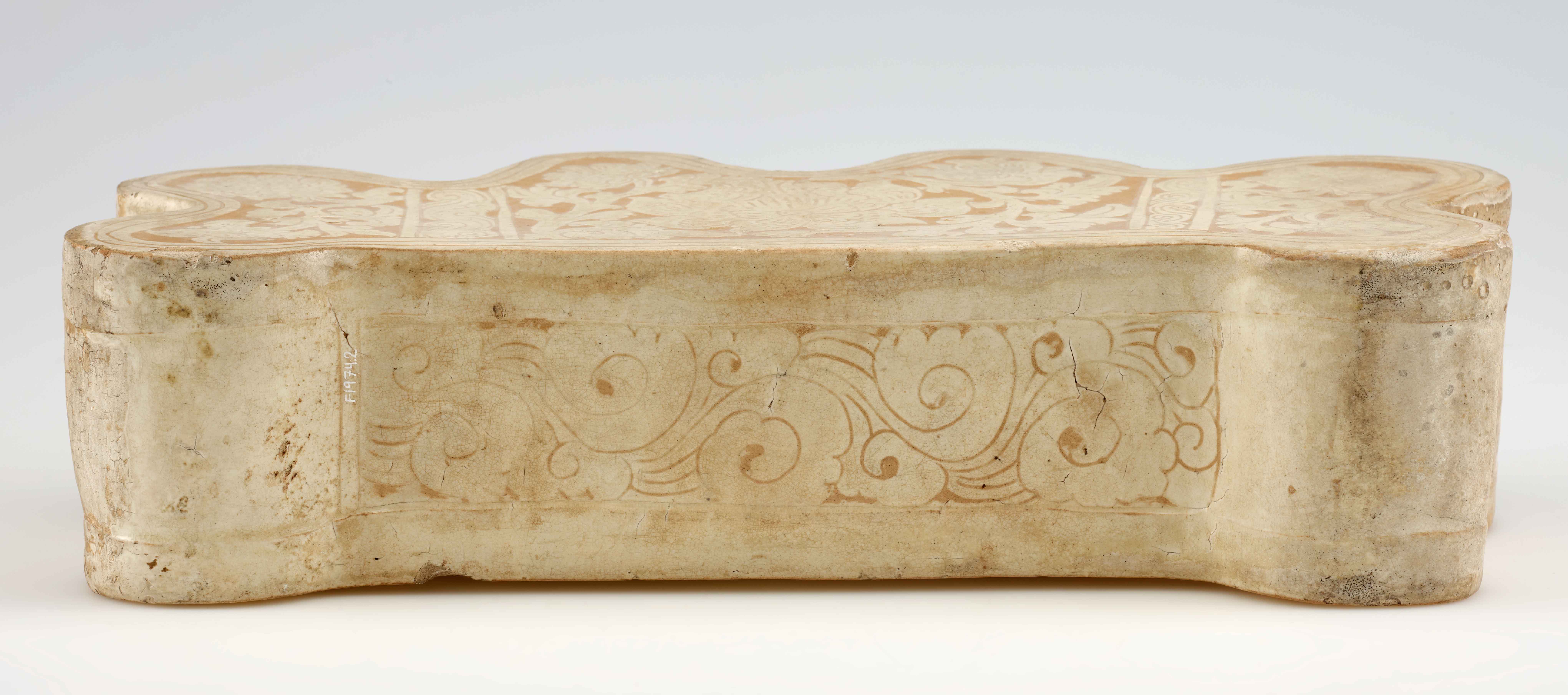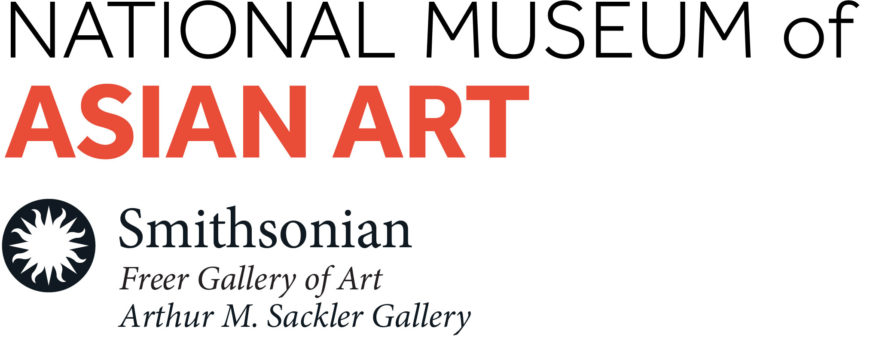
Pillow, Northern Song dynasty, 1063, Cizhou-type ware, stoneware with white slip under transparent colorless glaze, China, probably southern Shaanxi province, 19.2 x 39.8 x 10 cm (Freer Gallery of Art, Smithsonian Institution, Washington, DC: Gift of Eugene and Agnes E. Meyer, F1974.2)
The format of this pillow is a novelty. It is in the form of a mountain with four peaks. On one surface of the pillow, a large peony flower appears in the center. It is surrounded by four peony blooms, each corresponding to a mountain peak, connected to leafy scrolls.

Pillow, Northern Song dynasty, 1063, Cizhou-type ware, stoneware with white slip under transparent colorless glaze, China, probably southern Shaanxi province, 19.2 x 39.8 x 10 cm (Freer Gallery of Art, Smithsonian Institution, Washington, DC: Gift of Eugene and Agnes E. Meyer, F1974.2)
On the opposite side, two large circles sit in the middle, each filled with a repeating pattern of small diamonds. Leaf designs occupy the rest of the space. The decorations are executed in low relief in white on an ochre background. A layer of transparent colorless glaze covers the entire pillow. Both the form and the decorations are rendered symmetrically. The pillow was used by laying it flat; however, it’s likely that during the day it was placed upright on the narrow end with the “mountain range” top facing skyward. That way the pillow became not only a functional object but also a beautiful decoration in the living space.

Pillow, Northern Song dynasty, 1063, Cizhou-type ware, stoneware with white slip under transparent colorless glaze, China, probably southern Shaanxi province, 19.2 x 39.8 x 10 cm (Freer Gallery of Art, Smithsonian Institution, Washington, DC: Gift of Eugene and Agnes E. Meyer, F1974.2)
The potter of the pillow first shaped the clay body of the pillow, and when it was leather hard, coated it with ochre-colored slip (clay mixed with water and coloring agents to make a thick, smooth liquid). When dry, he added a layer of white-colored slip on top of the ochre. When the white slip was nearly dry, he carved away areas of it to create a design that stood in contrast to the underlying ochre. Next, using a sharply pointed tool he incised (cut fine details), such as the outlines for the flower petals, into the white slip. The technique of carving slip is called sgraffito (scratched decoration). A clear glaze was applied to the pillow and it was fired. As seen on this pillow, the technique of slip carving makes clever decorative use of different colors. Cizhou wares, a type of stoneware made at many kilns in northern China, mostly between the Northern Song dynasty (960–1127) and the end of the Yuan dynasty (1279–1368), frequently used slip decoration that indicates it was made in 1063.
Ceramic pillows in China were first produced during the Tang dynasty (618–907). They became a popular domestic item among middle- and upper-class families during the Song dynasty. Ceramic pillows were used not only by the living but for burial as well.
 This resource was developed for Teaching China with the Smithsonian, made possible by the generous support of the Freeman Foundation
This resource was developed for Teaching China with the Smithsonian, made possible by the generous support of the Freeman Foundation
For the classroom
Discussion questions:
- Imagine you used this pillow to rest your head on. How would you feel using this pillow? Today, soft pillows are the norm, but hard headrests were used in ancient Mesopotamia and many Asian cultures. Research when and where ceramic pillows have been used and the beliefs about sleep that surrounded them.
- The Chinese believed that the images on a pillow could affect the sleeper, so images related to nighttime, dreams, and sleep were often selected. Design imagery for your own (hard or soft) pillow decoration. What would you choose to include?
- Peonies like those depicted on this pillow, along with other flowers such as plum blossoms, orchids, lotus flowers, and chrysanthemums, often carry important symbolic meaning in traditional Chinese art. Research the qualities associated with peonies and other flowers, and present your findings in visual or written form.

